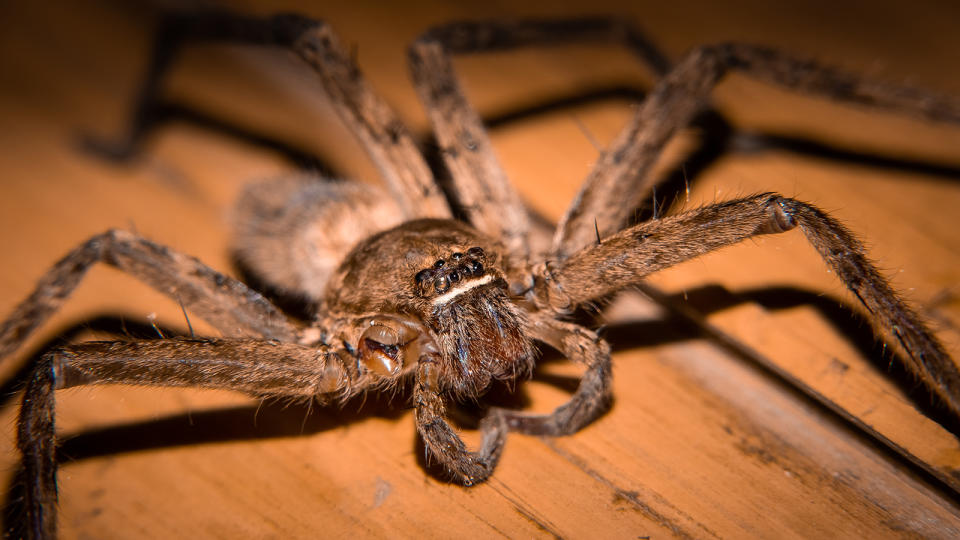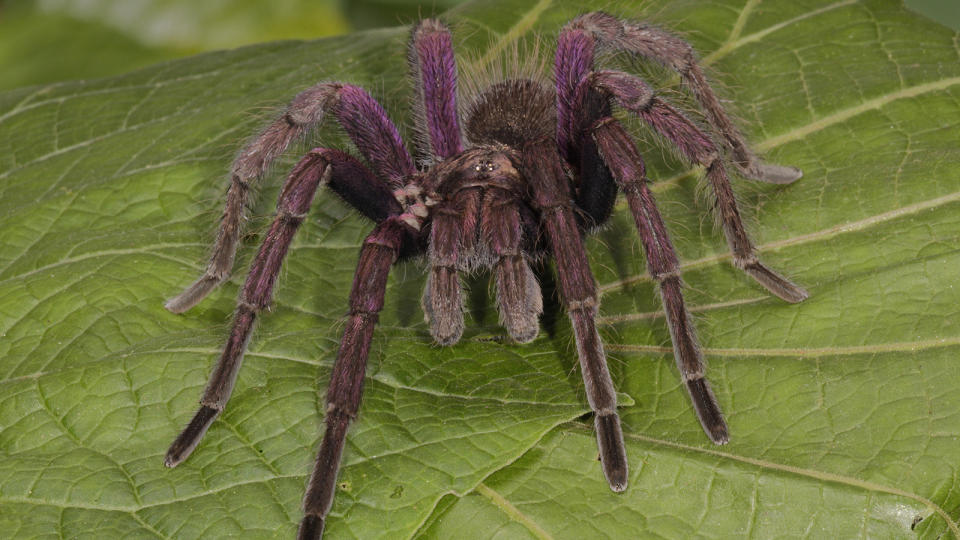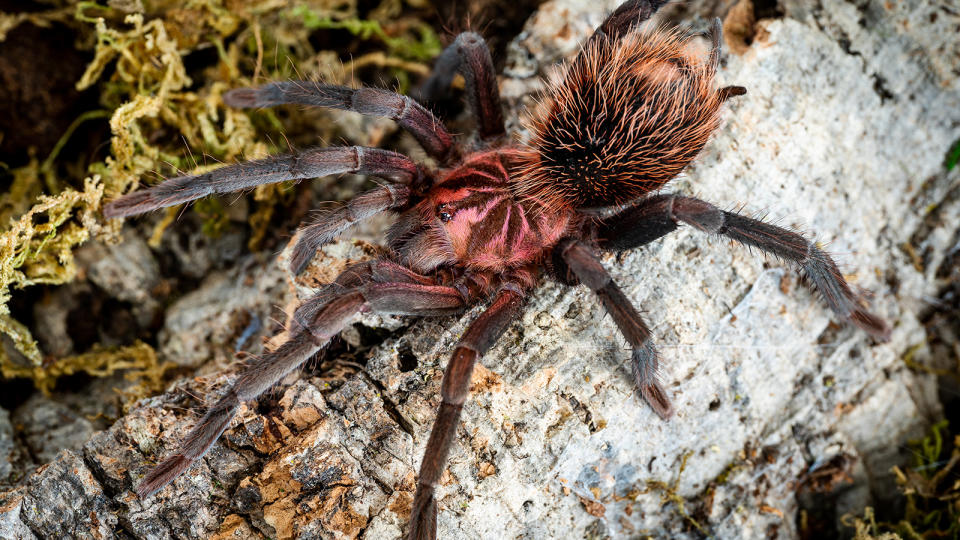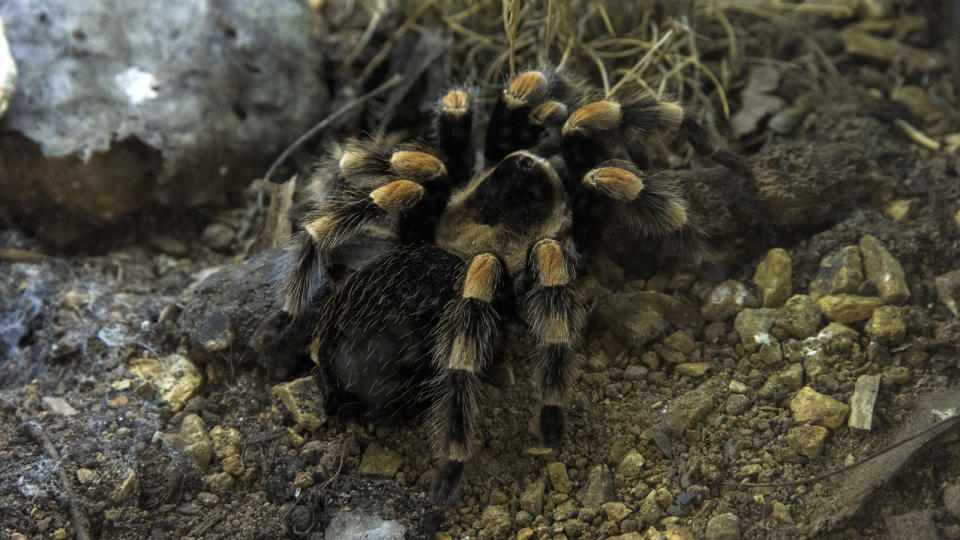The Biggest Spider in the World (by Weight and by Leg Span)
Key Takeaways
The Goliath birdeater spider, native to South America’s rainforests, is the biggest spider in the world, with a leg span reaching up to 12 inches (31 cm).
The giant huntsman spider, found in Laos, holds the record for the largest leg span at around 12 inches. It prefers to hunt instead of building webs.
Prehistoric spiders tended to be larger on average than their modern counterparts, with most fossils discovered sporting leg spans of at least a few inches. However, the largest species today eclipse any known fossils.
In the often misunderstood world of arachnids, the biggest spider in the world stands out among its giant kin. Enormous, eight-legged creatures — ranging from the Goliath birdeater to the Colombian lesserblack tarantula — showcase an astonishing diversity in size, habitat and behavior.
While they may incite fear due to their impressive dimensions, these spiders play crucial roles in their ecosystems and have become subjects of significant scientific interest and study.
9 Largest Spiders on the Planet
Let’s take a closer look at some of the biggest arachnids around the globe and learn about their behaviors and ecosystems.
1. Goliath Birdeater Spider
Goliath birdeater spider. Jasius / Getty Images
Well, this spider (sometimes misnamed the Goliath bird-eating spider) is huge, but it doesn’t eat birds often enough to warrant the name. That said, at least half of the Goliath birdeater’s name is accurate because it’s a real giant.
It’s the world’s largest spider — and the heaviest. Native to South America’s rainforests, this Goliath weighs as much as a hockey puck, with a body the size of a midsized smartphone and a leg span reaching up to 12 inches (30 centimeters).
Is the Goliath Birdeater Dangerous?
Although it has an intimidating name and size, this face-sized tarantula is relatively harmless to humans thanks to its docility. Its venom isn’t highly toxic to us, so, to protect itself, it employs unique defensive tactics.
Rather than inject venom when threatened, it releases urticating hairs from its abdomen. These barbed hairs embed themselves in the skin of larger predators or humans attempting to handle the spider, causing a burning pain and giving them plenty reason to back off.
The tarantula also makes a distinct sound by rubbing its hind legs together — a process known as stridulation, similar to the chirping of crickets. It can be heard by humans and animals alike from up to 15 feet (4.6 meters) away.
What Do Goliath Birdeaters Eat?
All types of critters are on the menu for this behemoth as the birdeater preys on insects, frogs, small rodents and occasionally birds.
As a ground hunter, it uses its potent neurotoxin to immobilize prey on the ground before dragging it back to its burrow for a private feast. The neurotoxin liquefies the prey’s insides, which the spider then consumes.
Birdeaters as Pets
In the exotic pet trade, these spiders are valued for their size and longevity, with females living up to 20 years — significantly longer than their male counterparts, which can live up to six years in captivity.
2. Giant Huntsman Spider
Giant huntsman spider. Jeroen Mikkers / Shutterstock
This leggy spider might not be as famed as its birdeater cousin, but it’s a record-breaker in its own right. The huntsman ties for the title of the largest leg span of any spider in the world: a staggering 12 inches (30 centimeters).
Discovered in a cave in Laos, this huntsman doesn’t build webs. Instead, it roams and hunts, true to its name, showcasing incredible speed and agility. Unlike many of its kin, the huntsman spider prefers cave walls to forest floors, making it a fascinating subject for arachnologists.
Are Giant Huntsman Spiders Dangerous?
While its appearance might seem intimidating, this spider is generally shy and avoids human contact. Its venom, though potent enough to subdue its prey, is not considered dangerous to humans.
So, while its size might be awe-inspiring, huntsman spiders are more a wonder of nature than a threat, playing a vital role in controlling insect populations in its habitat.
A Desert Cousin
If you venture into the deserts of the Middle East, you may also find a smaller relative of this species known as the sand dwelling huntsman spider. This nocturnal species waits out the day buried underneath sand dunes, and then emerges at night to pursue small ground dwelling animals.
3. Brazilian Salmon Pink Birdeater
Brazilian salmon pink birdeater. tatianaput / Shutterstock
The Brazilian salmon pink birdeater (Lasiodora parahybana) is a sight to behold in the spider world. This species is one of the most impressive tarantulas, renowned for its significant size.
With a leg span that can reach up to 10 inches (25.4 centimeters), it’s like encountering a dinner plate scuttling across the forest floor.
Originating from northeastern Brazil, it’s not just their size that’s striking, but also their beautiful, salmon-pink hair, giving them a unique flair among tarantulas.
Despite their daunting size and appearance, birdeaters are known to be relatively docile. They might have intimidating fangs, but their venom is mild to humans, making them more of a gentle giant in the spider realm.
Beware the Brazilian Wandering Spider
In Brazil you also may find the Brazilian wandering spider which stalks the jungle floors of South America and packs a painful bite which can also be dangerous to humans.
This family of species has a leg span of up to 7 inches (18 centimeters) and is also known as a banana spider thanks to its tendency to stow away on fruit shipments and potentially pose a threat to hapless dock workers.
4. Hercules Baboon Spider
Hercules baboon spider Notafly / Wikimedia Commons
The Hercules baboon spider (Hysterocrates hercules) is a bit of an enigma in the spider world, and a name like “Hercules” definitely sets some high expectations.
Native to central African countries like Nigeria, this species is rumored to be one of the largest tarantulas in the world, yet it remains shrouded in mystery. Sightings are rare, making it something of a legend among arachnid enthusiasts.
Its supposed size, with a leg span that could rival the largest of spiders, adds to its mythical status. Some estimates suggest that its leg span could reach around 8 inches (20.3 centimeters) or more, but these figures should be taken with caution as they are based on limited observations and anecdotal reports
Despite its formidable name, the Hercules spider is more reclusive than aggressive. It prefers to stay hidden, making its true size and habits subjects of speculation. If you’re lucky enough to spot one, you’re witnessing a rare moment in the wild.
Another Baboon Spider
Similar in size and appearance to this species is the king baboon spider, which lives in deep burrows underneath the grasslands of East Africa and can rub its legs together like a cricket to make noise.
This chirp is a warning call for trespassers, politely letting them know they are about to be within striking distance.
5. Colombian Giant Tarantula
Colombian giant tarantula. Robert Oelman / Getty Images
The Colombian blue bloom tarantula (Pamphobeteus nigricolor), a dazzling inhabitant of the Colombian rainforests, stands out with its striking blue coloration. With a leg span that can reach up to 7 inches (17.8 centimeters), it’s not only a visual spectacle but also boasts a significant size.
Known for its relatively docile nature, the Colombian blue bloom can still be a handful due to its skittishness, making it a captivating yet challenging pet. Ideal for those who appreciate beauty from a distance, this tarantula is more of a display species, thriving in a tranquil environment with minimal interference.
Its preference for solitude and the unique charm it brings to a terrarium make the Colombian tarantula a cherished species among tarantula aficionados.
9. Colombian Lesserblack Tarantula
Colombian lesserblack tarantula. tempisch / Shutterstock
The blue bloom isn’t the only massive tarantula from the rainforests of Colombia. The lesserblack tarantula (Xenesthis immanis) truly stands out in the world of arachnids.
With a leg span reaching up to 7 inches (17.8 centimeters), its size alone is enough to capture anyone’s attention. But it’s the stunning visual contrast of its deep black body adorned with vibrant patches that makes it a true spectacle.
Despite its imposing appearance, the lesserblack is known for a relatively docile temperament, making it a sought-after species among tarantula enthusiasts and keepers. However, its size and strength demand respect and careful handling.
In captivity, these tarantulas can live for a significant amount of time. Females generally live longer than males, with lifespans ranging from 12 to 20 years for females and up to five years for males.
Measuring Spiders by Body Length
When you’re measuring giant spiders, it basically comes down to two things: how long their bodies are and how wide they can stretch their legs.
First up, we’ve got body length. This is like measuring a person from head to toe. You start at the spider’s head, or the prosoma as the science folks call it, and go all the way to the end of its abdomen, the opisthosoma. This gives you the size of the spider’s main body — without the legs.
It’s a useful measurement for scientists who need to compare different spiders. The most muscular spider species in this category usually belong to the tarantula family.
Measuring Spiders by Leg Span
Leg span is the more dramatic way to measure spiders, especially big ones like tarantulas. You’re essentially stretching out a spider’s legs as far as they can go and measuring from the tip of one leg to the tip of the leg on the opposite side.
This number is usually bigger and a bit more eye-catching, but it can change a bit if the specimen curls up or loses a leg.
Now That’s Interesting
The egg sac of a Goliath birdeater is about the size of a tennis ball. It can contain as many as 200 eggs, which the mother carries on her back while they gestate.
Brazilian salmon pink birdeater. Mark Newman / Getty Images
3. Brazilian Salmon Pink Birdeater
The Brazilian salmon pink birdeater (Lasiodora parahybana) is a sight to behold in the spider world. This species is one of the most impressive tarantulas, renowned for its significant size. With a leg span that can reach up to 10 inches (25.4 centimeters), it’s like encountering a dinner plate scuttling across the forest floor.
Originating from northeastern Brazil, it’s not just their size that’s striking, but also their beautiful, salmon-pink hair, giving them a unique flair among tarantulas.
Despite their daunting size and appearance, they’re known to be relatively docile. They might have intimidating fangs, but their venom is mild to humans, making them more of a gentle giant in the spider realm.
4. Hercules Baboon Spider
The Hercules baboon spider (Hysterocrates hercules) is a bit of an enigma in the spider world, and a name like “Hercules” definitely sets some high expectations.
Native to Africa, this species is rumored to be one of the largest tarantulas in the world, yet it remains shrouded in mystery. Sightings are rare, making it something of a legend among arachnid enthusiasts.
Its supposed size, with a leg span that could rival the largest of spiders, adds to its mythical status. Some estimates suggest that its leg span could reach around 8 inches (20.3 centimeters) or more, but these figures should be taken with caution as they are based on limited observations and anecdotal reports
Despite its formidable name, the Hercules spider is more reclusive than aggressive. It prefers to stay hidden, making its true size and habits subjects of speculation. If you’re lucky enough to spot one, you’re witnessing a rare moment in the wild.
Colombia tarantula. Robert Oelman / Getty Images
5. Colombian Giant Tarantula
The Colombian giant redleg tarantula (Megaphobema robustum) is quite the showstopper in the world of arachnids. Hailing from the rainforests of Colombia, this tarantula isn’t just giant by name.
With a leg span that can stretch up to 8 inches (20.3 centimeters), it’s like encountering a small pizza on eight legs. What sets this species apart, aside from its impressive size, is its striking appearance.
The Colombian redleg boasts a velvety black body contrasted with vibrant reddish hairs, making it a visual treat. Despite its daunting presence, it’s known to be more of a gentle giant, with a calm demeanor, unless provoked. It’s a burrower by nature, creating impressive tunnels as homes.
While it might seem fearsome, this tarantula plays an important ecological role, and its venom, though effective on small prey, poses little threat to humans.
6. Poecilotheria Rajaei
The Poecilotheria Rajaei, discovered relatively recently in Sri Lanka, adds a dazzling flair to the spider world. Known for its strikingly beautiful and intricate patterns, this species exhibits a blend of geometric designs that are both mesmerizing and a bit intimidating.
Its leg span can reach up to 8 inches (20.3 centimeters), making it a sizable entry in the big spider league.
What’s really fascinating about Poecilotheria Rajaei, aside from its size, is its arboreal nature. Unlike many large, ground-dwelling tarantulas, this species prefers the lofty heights of trees. Though it’s a sight to behold, it’s wise to admire from a distance, as its venom is potent.
7. Brazilian Giant Tawny Red Tarantula
The Brazilian giant tawny red tarantula (Grammostola anthracina) is another star in the tarantula universe. This South American native, particularly found in Brazil, boasts a leg span that can reach up to 7 inches (17.8 centimeters) — large enough to make even non-arachnophobes uncomfortable.
Its most striking feature is its tawny-red coloration, which gives it a regal and intimidating appearance. But despite its fearsome look, this tarantula is known for its relatively docile nature, often surprising those who expect a more aggressive demeanor.
It’s a burrowing species, preferring to spend its time in well-crafted underground lairs. For spider enthusiasts, the tawny red tarantula is a sought-after species, mostly due to its size, beauty and manageable temperament.
8. Colombian Blue Bloom Tarantula
The Colombian blue bloom tarantula (Pamphobeteus nigricolor), a dazzling inhabitant of the Colombian rainforests, stands out with its striking blue coloration, a hue that’s not just rare but also mesmerizing. With a leg span that can reach up to 7 inches (17.8 centimeters), it’s not only a visual spectacle but also boasts a significant size.
Known for its relatively docile nature, the Colombian blue bloom can still be a handful due to its skittishness, making it a captivating yet challenging pet. Ideal for those who appreciate beauty from a distance, this tarantula is more of a display species, thriving in a tranquil environment with minimal interference.
Its preference for solitude and the unique charm it brings to a terrarium make the Colombian tarantula a cherished species among tarantula aficionados.
Colombian lesserrblack tarantula. tempisch / Shutterstock
9. Colombian Lesserblack Tarantula
The blue bloom isn’t the only massive tarantula from the rainforests of Colombia. The lesserblack tarantula (Xenesthis immanis) truly stands out in the world of arachnids.
With a leg span reaching up to 7 inches (17.8 centimeters), its size alone is enough to capture anyone’s attention. But it’s the stunning visual contrast of its deep black body adorned with vibrant patches that makes it a true spectacle.
Despite its imposing appearance, the lesserblack is known for a relatively docile temperament, making it a sought-after species among tarantula enthusiasts and keepers. However, its size and strength demand respect and careful handling.
In captivity, these tarantulas can live for a significant amount of time. Females generally live longer than males, with lifespans ranging from 12 to 20 years for females and up to five years for males.
Camel spider. Dmitry Fch / Shutterstock
Honorable Mention: Camel Spider
Ah, the camel spider, a creature shrouded in wild myths and hair-raising tales from desert battlegrounds. While not true spiders, these members of the Solifugae order are often lumped into the category due to their fearsome appearance.
Found in desert regions, they can reach sizes of about 6 inches (15.2 centimeters), which is quite large for a creature often mistaken for a spider.
Camel spiders are known for their formidable jaws, which are disproportionately large compared to their body size, and their astonishing speed, darting across desert sands.
Despite popular legends, they are neither venomous nor do they chase humans. Instead, these fascinating creatures are adept hunters of insects and small animals, playing an important role in their arid ecosystems.
Now That’s Interesting
The egg sac of a Goliath birdeater is about the size of a tennis ball.
Original article: The Biggest Spider in the World (by Weight and by Leg Span)
Copyright © 2025 HowStuffWorks, a division of InfoSpace Holdings, LLC, a System1 Company
#Biggest #Spider #World #Weight #Leg #Span







